William Shakespeare (1564-1616):
Life, Love and his Sonnets
Shakespeare's Sonnets
(For a general introduction to Shakespearen sonnets,
please read Shakespeare's
Sonnets)
It takes time to appreciate Shakespeare's sonnets,
both because of their intricate sentence structure and elaborate pattern
of sounds, imagery and ideas. After reading a sonnet once and vaguely
understanding its meanings, you need to dwell on its image, sound/rhythm
and logical pattern in order to find out its deeper meanings.
It is also important to remember that a Shakespearean sonnet is composed
of three quartrains (4-line stanza) and a couplet (2 lines).
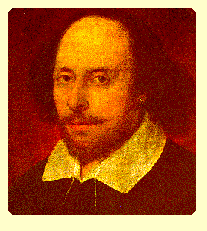 "Shall
I Compare Thee to a Summer's Day" "Shall
I Compare Thee to a Summer's Day"
E-Text;
Reading;
Song
by Brian Ferry; another
reading by Michael Sheen
Questions for Group Discussion and Journal
-
This poem is an extended comparison between the speaker's lover and a summer's
day. According to the first two lines, how is the speaker's lover
UNLIKE a summer's day?
-
Lines three through eight point out a number of negative characteristics
of summer. Identify them.
-
Lines nine through fourteen offer a view of the lover's many contrasts
with nature. How is she better than a summer's day?
-
What will keep her young forever? What does this poem suggest about the
value of art?
-
Identify the metaphors, personification, and hyperbole in this sonnet.
-
Try to feel and describe the effects pf spondaic (double stress) rhythm
in line 3, as opposed to the predominantly iambic rhythm in other lines,
esp. ll. 4, 7-8 and 13-14..
Application and Wild Association
Using your handbook, or Shakespeare's
Sonnets page, to help you, describe the difference between a
Shakespearean sonnet and a Petrarchan sonnet. Compare and contrast
this sonnet with one of the Petrarchan sonnets we have already read.
Compare and contrast the view of art in this poem with the views
expressed in "Ozymandias" and "Ode on a Grecian Urn." Also,
you can compare the way the lady is praised in this poem with that of "She
Walks in Beauty," "On Stella's Birthday" and "To His Coy Mistress."
If you were going to write a poem, what would you compare your lover to?
What do you think about the following parody of Shakespeare's sonnet 18?
Howard Moss's "Shall I Compare Thee to a Summer's Day"
Who says you're like one of the dog days?
You're nicer. And better.
Even in May, the weather can be gray,
And a summer sub-let doesn't last forever.
Sometimes the sun's too hot;
Sometimes it is not.
Who can stay young forever?
People break their necks or just drop dead!
But you? Never!
If there's just one condensed reader left
Who can figure out the abridged alphabet,
After you're dead
and gone,
In this poem you'll live on!
|
back to the top
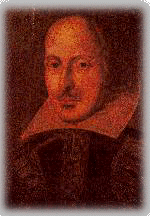 "That
Time of Year Thou Mayest in Me Behold" "That
Time of Year Thou Mayest in Me Behold"
E-Text--1.
plain, 2. with visualization
of the poem; Reading
Questions for Group Discussion and Journal
1. logical structure The three quartrains repeat the words "in
me" ("in me behold"; "In me thou see'st"; "In me thou see'st"), and the
final couplet carries this idea ("This thou perceiv'st") to a conclusion
(which makes thy love more strong..."). What does the listener see
in the speaker, that makes the former loves the latter more?
--If the final couplet presents a kind of carpe diem
argument, how is this poem different from a typical carpe diem poem?
2. metaphor and imagery
-
In the first quatrain, what season of the year does the speaker
compare himself to? Is the speaker old or young? How does the speaker feel
about growing old?
-
In the second quatrain, what time of the day does the speaker compare
himself to? How is he like twilight? How is night like "death's second
self"?
-
In the third quatrain the speaker compares himself to the dying
of a fire. How is his old age like a "glowing fire"?
-
In the final couplet the speaker again addesses "thou." Who
is he talking to? What is their relationship? What does he think will be
the result of the listener's "perceiving" that his life is nearing its
end?
As you may have found out, what the listener
sees in the speaker is aging and the coming death, which is compared to
autumn, sunset and dying fire respectively in the three quartrains.
Around each of these metaphors, again, images and metaphors cluster.
-
clusters of metaphors & images
-
In each set of images/metaphors, some worth close analysis. How is "Bare
ruined choirs"(l. 4) related to autumn trees? What does "Death's
second self" (l. 8) refer to? Why does fire lie "on the ashes of
his youth" (l. 10)?
-
Is there anything common among these three sets of images? (Are there
any common images of, say, light or heat in the poem? Do the images
remind us of the past youth, or suggest death, or both?)
Do the metaphors of aging--i.e., autumn, sunset and dying fire--suggest
any kind of development (clue: in terms of the length of the three phenomena)?
back to the top
Courting sonnet from Romeo and Juliet
video: the
first sight, the
sonnet, the song
Brief
summary of the play (with stills from its most recent film version);
a
more detailed summary quoting the courting sonnet
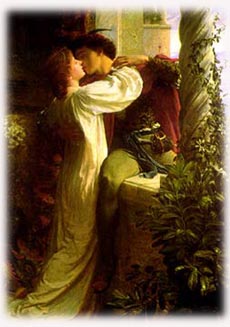 Questions
for Group Discussion and Journal: Questions
for Group Discussion and Journal:
-
This brief excerpt from the play is a poem by itself. What is the form
of this poem? Notice that Romeo speaks the first quatrain, Juliet the second,
and they alternate lines in the final six lines.
-
In the first quatrain Romeo uses religious imagery when describing
his relationship to Juliet. Romeo thinks that his hands may have treated
Juliet too roughly, so what does he offer to do?
-
In the second quatrain Juliet continues the religious imagery. How does
she respond to Romeo's offer? What would she rather do?
-
In line 101 Romeo repeats his offer, and in the following line Juliet again
politely and teasingly rejects his offer. How does Romeo a third time try
to persuade Juliet to kiss him?
-
What decision do the two lovers make in the final couplet? Why does
Juliet say "You kiss by th'book"?
Frank Dicksee. Romeo and Juliet, 1884. Southampton
City Art Gallery, Southampton, England. From Romeo and Juliet,
in Shakespeare
Illustrated
Readings in Context: a. Before the sonnet (their first
conversation), Romeo, like Byron in "She Walks in Beauty," compares
Juliet to light or jewels at night and describes her as "true beauty,"
"beauty too rich for use, for earth too dear" (I.5 ll. 43-52 video).
What kind of love (at first sight) is this? Religious and pure?
Rashful? Bear in mind that Romeo goes to the ball to find his girlfriend
Rosaline, but not Juliet.
b. The use of religious metaphors, their tryst at night, as
well as the fact that their love is forbidden, put Romeo and Juiliet in
the tradition of religious and courtly love (Cf. Traditional
Concepts of Love)
-
Application and Wild Association
Compare and contrast the ways Romeo courts Juliet in this sonnet with the
ways used by the speaker respectively in Marvell's "To His Coy Mistress"
and Donne's "The Flea."
back to the top
Soliloquy from Macbeth,
Act V Scene V
reading
(video)
general
introduction with pictures & film stills
a summary of
the scenes in Act V, quoting the soliloquy in scene V
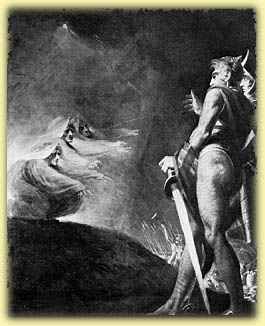 Questions
for Group Discussion and Journal: Questions
for Group Discussion and Journal:
-
This short speech by Macbeth takes place at the point in the play when
he has just learned that his wife is dead. He presents a pessimistic view
of life and living. Does he, like the speaker in "To His Coy Mistress,"
present a carpe diem view of each day? If not, how does he feel
about the passage of time? For Macbeth the passage of time only leads to
what?
-
Lines 25 and following use a variety of figures of speech. What does Macbeth
compare life to in those metaphors?
-
hen Macbeth describes life as being "a tale / Told by an idiot, full of
sound and fury / Signifying nothing," what does he mean? Explain this metaphor.
Henry Fuseli. Macbeth, Banquo and the Witches on the Heath,
1793-4. Petworth, The National Trust. from Macbeth,
in Shakespeare
Illustrated
Application and Wild Association--Time,
Life and Aging
Contrast the attitudes toward life and time expressed in this poem with
"That Time of Year." You can also compare the different views about
life, time and aging expressed inhese two poems, as well as "To
His Coy Mistress" and "Ulysses." How is time, or experiences in life,
looked in these poems? Does the speaker of each poem look at life
as process of gain or loss or both? How about you?
Readings in Context: We need to read the whole play to
understand why for Macbeth life is emptied of significance. It suffices
now to know what before Act five, Macbeth has gone through a rise
to power and then a serious downfall, during which he commits one murder
after another and goes through some psychological struggles, too.
In other words, his life is an eventful one, but why is it "a tale told
by an idiot"? This is a question for you to keep in mind, but not
to answer now.
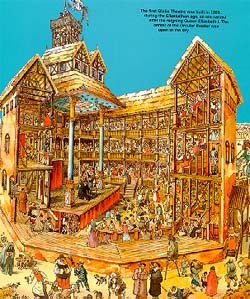
The first Globe Theatre was
built in 1599, during the Elizabethan age. The center of the circular
theater was open to the sky. The stage's roof was painted with stars
and supported by two brightly colored pillars. When the silk flag
flew over the 30-foot-high walls of the theatre, the townpeople knew to
head for the ferries. It was time of a play such as one of William
Shakespeare's. Since there were no reserved seats, the crowds arrived
long before the opening scenes. They paid their pennies and elbowed
their way up to the stage to see the fierce witches of Macbeth or the tragic
lovers in Romeo and Juliet. The English theatres of Shakespeare's
time did not use curtains. At the end of a scene, the "dead bodies"
would just be carried offstage. (The World of Theater
New York: Scholastic 1993: pp 16-17..)
back to the top
William
Shakespeare: Selective Relevant Links
 Overviews and Biographies
Overviews and Biographies
-
Bio,
with images & an Approximate Chronology of Shakespeare's Plays
-
Bio from Poetry
Archive
 Sites
for Fun & Visual Stuffs Sites
for Fun & Visual Stuffs
-
Shakespeare
Illustrated, a work in progress, explores nineteenth-century paintings,
criticism and productions of Shakespeare's plays and their influences on
one another. (from Emory U.)
-
Shakey's Place:
The 3D Globe Theatre Internet Experience including introduction
and links to Shakespeare's plays and sonnets; both informative and (visually)
entertaining!
-
Shakespeare
Movies (Searchable database)
-
Shakespeare Web--an interactive,
hypermedia environment dedicated to the enjoyment of Shakespeare's works.
-
SHAKESPEAREAN
LIGHTHOUSE GREETINGS--To create a North Carolina Shakespearean Outer
Banks Lighthouse greeting for a friend or yer pirate sweetheart or somebody,
fill in all the required information, select a lighthouse, choose
one of Shakespeare's sonnets, and press the "Ship Great Thoughts Greeting"
button at the very bottom of this page. (Free of charge.)
 Shakespeare's Sonnet & Sonnet in General
Shakespeare's Sonnet & Sonnet in General
-
Sonnet 18 ("Shall I Compare Thee"): Brief
Introduction
-
Sonnet 74 (That Time of Year"): Brief
Introduction
-
Shakespeare's
Sonnets
-
E-Texts (offered by wiretap.spies.com): Poetry,
including Sonnets
-
Sonnet Central,
an archive of English sonnet E-Text (some audio), commentary,
pictures, and relevant web links. Sonnets are grouped by British periods
and sonnet from elsewhere (Australia, New Zealand, the U.S.); can also
be accessed quickly via an
alphabetical list of authors
 Shakespeare's Plays
Shakespeare's Plays
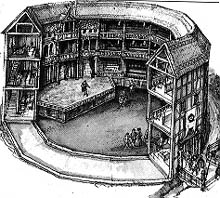 The
Elizabethan Stage, Rose Theatre reconstructed Shakespeare: Court, Crowd
and Playhouse p. 69. The
Elizabethan Stage, Rose Theatre reconstructed Shakespeare: Court, Crowd
and Playhouse p. 69.
Romeo and Juliet
for advanced studies: online
texts of the two quarto and the one folio versions of the play
Mecbeth
-
The Mecbeth Site--an
interactive site devoted to the play, with many interesting pages offering
audio and visual materials
-
Shakespeare
and His Theatre
-
Synopsis:
detailed act-by-act synopsis of some of Shakespeare's plays
-
E-Texts (offered by wiretap.spies.com): Comedies,
Histories,
Tragedies
-
Performance and Analysis
 For
Further Studies: For
Further Studies:
-
Untitled
Essay on Love in lyric poems from the Middle Age and the Renaissance
period in England
-
Important Gateways to Shakespeare Studies:
-
Major Shakespeare Homepage
-
The Internet Shakespeare
Homepage including:
-
The Internet Shakespeare Editions: under construction
-
The Foyer:
This section of the site collects all materials that deal with the overall
structure of the Editions.
-
The Library: under construction
-
The Annex:
The Annex makes available various materials in a more informal format:
drafts,
discussions, and non-refereed texts that will nonetheless be useful
to Shakespeare scholars.
-
The Oxford Society
page: the oldest continuously operating organization involved in the two-centuries
old Shakespeare authorship debate.
-
The Richard III and Yorkist History ServerThis
site is devoted to the study of King Richard III, last of the medieval
English kings the Wars of the Roses, a dynastic struggle in the later middle
ages that pitted Yorkist against Lancastrian fifteenth-century England
and its culture the reputation of Richard III in history, literature, and
drama, especiallyShakespeare.
 E- Texts
E- Texts
 Criticism Criticism
back to the top
Renaissance:
Relevant Links
Renaissance:
its definition and continental philosophical roots
back to the top
Internet-Assisted
Course page
|
 "That
Time of Year Thou Mayest in Me Behold"
"That
Time of Year Thou Mayest in Me Behold"
